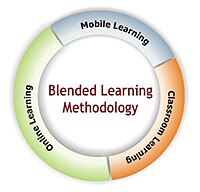Open and online education
| [▲]Learning and Teaching in Practice | |
|---|---|
| Module 2: Adult learning theory and Praxis | |
| Theoretical Concepts | Introduction | Theories and models | Open and online education | Summary |
Open education was originally offered by organisations who wanted to make studying more accessible. Therefore, barriers to study were eliminated. Barriers such as entry requirements, rigid start dates, and learning that was restricted to specific locations. In open education, learners usually study by distance and the learning is more flexible. The term open and distance learning is often used in combination.
Advances in technology mean that open and distance learning is now more commonly offered online. This has changed the ways in which learning and teaching can occur. Supporting learning in an online environment doesn’t just mean taking what happened in a traditional classroom and putting that information online. It involves a different approach to learning and teaching, and this is known as online pedagogy.
In New Zealand, Open Polytechnic offers open and distance learning. In Australia, open education is available through 20 universities and TAFES at Open Universities Australia. Also, Open University in Britain and Athabasca University in Canada have been offering open and distance education for a long time.
Online Pedagogy
|
Contents
[hide]So what is online learning?
Sometimes, teachers and students wonder how traditional forms of education can be transferred to an online learning situation. How will teachers and students interact together online, synchronously or asynchronously?
Computer conferencing (e.g., Skype or Adobe Connect) or video conferencing may be used for real-time interactions. Discussion forums are often used for asynchronous interactions. The online learning environment may be contained in an institutional learning management system (e.g., Moodle) and password protected, or, it might be open and use Web 2.0 tools and approaches for social networked learning.
To fully understand this area, and how pedagogy has changed and developed with online learning, we suggest you explore the following resources, and consider how they relate to your area of practice as an educator and your current learning.
Extra resources
|
Another form of pedagogy to think about in this area is blended learning. What is it exactly?
Blended learning

The term blended learning is often used to describe courses where a mix of delivery and learning options are used. However, a definition is problematic and it is probably wise to consider not only how media and technologies are mixed with traditional forms of delivery, but also how aspects such as pedagogies, contexts and theories of learning are mixed or 'blended' Oliver and Trigwell (2005). For example, face-to-face (f2f) classes may be combined with online learning and mobile learning as shown in the diagram. In this way, resources can be provided in various ways using media such as videos, audio, e-books etc, and participants can use different tools to communicate with each other and the teacher, and to interact with the learning environment.
Your teaching philosophy and students' learning preferences may strongly influence the design of a blended learning environment. Therefore, the 'blendedness' may vary with some courses being mostly f2f with some email communication to a mix of f2f and online resources or a totally online course as shown in the diagram called Variations of blended learning programs. (Scroll down to see this once you have accessed the website.)
References
- Anderson, T. & Elloumi, F. (2004). Theory and practice of online learning. (2nd Edn.) Canada:Athabasca University.
- It is a free open e-book on various aspects of online learning.
- Connecticut Distance Learning Consortium. (n.d). What students want to tell. CTDLC.org E-learning Solutions. Retrieved from http://www.ctdlc.org/Evaluation/WhatStudentsWantToTell.cfm
- Oliver, M. & Trigwell, K. (2005). Can blended learning be redeemed? E–Learning, 2(1), 17-26. Retrieved from http://tinyurl.com/b5z93gd
- Sharples, M., McAndrew, P., Weller, M., Ferguson, R., FitzGerald, E., Hirst, T., Mor, Y., Gaved, M. & Whitelock, D. (2012). Innovating Pedagogy 2012: Open University Innovation Report 1. Milton Keynes: The Open University. Retrieved from http://www.open.ac.uk/blogs/innovating/
- Stephenson, J. (2002). Teaching & Learning Online: New Pedagogies for New Technologies. London: Kogan Page Ltd.